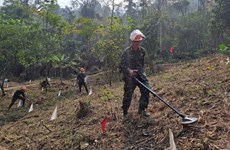5,000 flood-prone families need relocation: official
In the flood-prone central province of Quang Nam , a further
5,000-odd households need to be relocated to safe areas, an official
said.
In the flood-prone central province of Quang Nam , a further
5,000-odd households need to be relocated to safe areas, an official
said.
Nguyen Van Gap, head of the Department of Agriculture and Rural Development's Rural Development Division, said the province has several major rivers and streams which often flood in the rainy season, causing landslides and threatening lives and properties.
"Of the province's 18 districts and cities, 17 have had landslides or face the danger of landslides."
Since 1997 his division has joined local authorities to relocate more than 16,000 families at a cost of 29 billion VND (1.5 million USD), he said.
The province has also spent tens of billions of dong on building embankments along rivers and 100 new residential areas for more than 4,000 relocated households, he said.
In Dai Loc District in the downstream of the Thu Bon and Vu Gia Rivers, they have relocated nearly 1,000 families from 700 spots where there have been river and mountain landslides since 2001.
"The district has [another] 400 households living in landslide-prone areas," Phan Duc Tinh, deputy chairman of its People's Committee, said.
In the district's Dai Hong Commune, which has a 16-km stretch of the Vu Gia River, around 100ha of farmlands have been lost due to riverbank erosion since 2001.
Dang Van Ky , chairman of the commune People's Committee, warned that without proper protective measures, Ngoc Thach and Dong Phuoc hamlets will lose 300ha of farmlands to erosion.
Nguyen Thi Van, whose house is near the Vu Gia River in Dai Lanh Commune's Ha Duc Dong Hamlet in the same district, said: "We heard that local authorities are planning to move households here to safe areas but the relocation has not been carried out yet."
According to the Rural Development Division, the amount the province needs for relocating all threatened families is 10 billion VND (520,000 USD) a year. But since only 3 billion VND is earmarked, priority is given to households in high-risk areas.
Besides, with the amount of available land being limited, it is becoming hard for authorities to allot enough land for the relocated people's housing and production needs. Many have got only 150-200sq.m, just enough for housing./.
Nguyen Van Gap, head of the Department of Agriculture and Rural Development's Rural Development Division, said the province has several major rivers and streams which often flood in the rainy season, causing landslides and threatening lives and properties.
"Of the province's 18 districts and cities, 17 have had landslides or face the danger of landslides."
Since 1997 his division has joined local authorities to relocate more than 16,000 families at a cost of 29 billion VND (1.5 million USD), he said.
The province has also spent tens of billions of dong on building embankments along rivers and 100 new residential areas for more than 4,000 relocated households, he said.
In Dai Loc District in the downstream of the Thu Bon and Vu Gia Rivers, they have relocated nearly 1,000 families from 700 spots where there have been river and mountain landslides since 2001.
"The district has [another] 400 households living in landslide-prone areas," Phan Duc Tinh, deputy chairman of its People's Committee, said.
In the district's Dai Hong Commune, which has a 16-km stretch of the Vu Gia River, around 100ha of farmlands have been lost due to riverbank erosion since 2001.
Dang Van Ky , chairman of the commune People's Committee, warned that without proper protective measures, Ngoc Thach and Dong Phuoc hamlets will lose 300ha of farmlands to erosion.
Nguyen Thi Van, whose house is near the Vu Gia River in Dai Lanh Commune's Ha Duc Dong Hamlet in the same district, said: "We heard that local authorities are planning to move households here to safe areas but the relocation has not been carried out yet."
According to the Rural Development Division, the amount the province needs for relocating all threatened families is 10 billion VND (520,000 USD) a year. But since only 3 billion VND is earmarked, priority is given to households in high-risk areas.
Besides, with the amount of available land being limited, it is becoming hard for authorities to allot enough land for the relocated people's housing and production needs. Many have got only 150-200sq.m, just enough for housing./.












